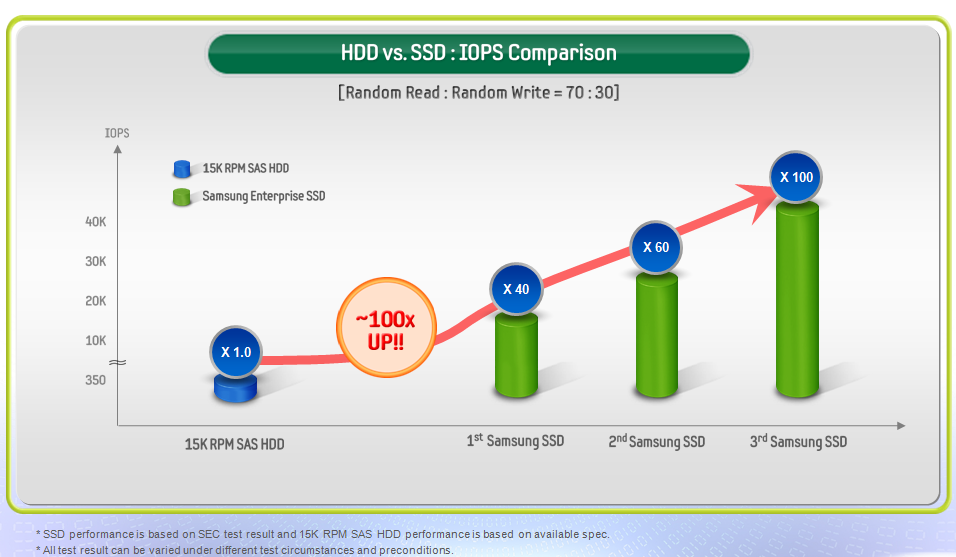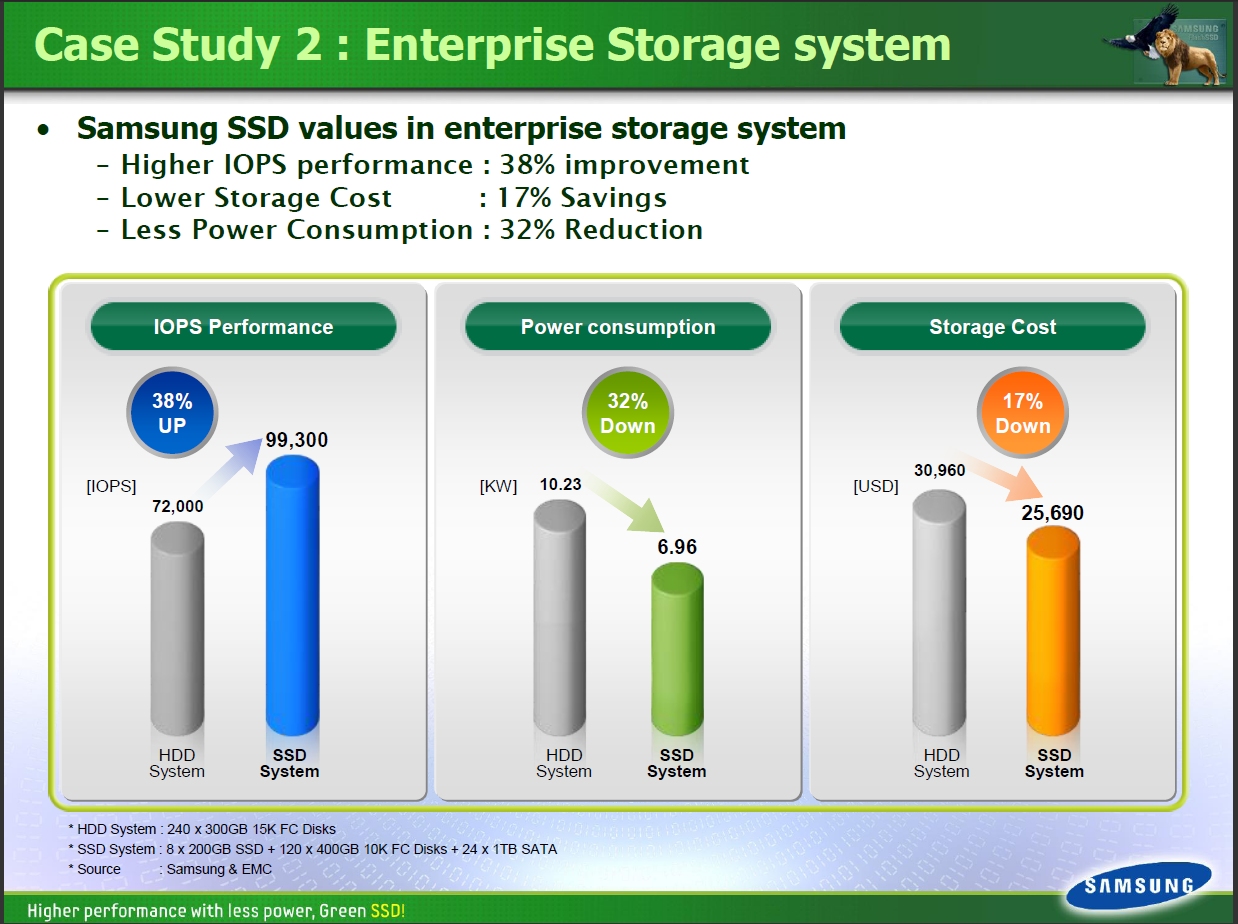SSDs In RAID: A Performance Scaling Analysis
RAID arrays with dozens of hard drives are not uncommon for reaching certain performance levels. We demonstrate how beautifully SSD RAID arrays can scale. There may come a time when a few flash-based drives will replace entire farms of hard disks.
I/O Performance In Abundance
Sequential read rates of more than 200 MB/s no doubt speak for SSDs, but whether the drive peaks at 230 or even 260 MB/s is of less importance when it comes to professional use. What is more important, especially in servers, is the number of I/O operations such a system can handle per second. Because the access times of SSDs are in the microsecond range, they outclass traditional hard drives in this respect.
Using the right flash drive can increase the I/O performance at a factor of up to three digits, according to Korean manufacturer Samsung. The image above shows the I/O performance of Samsung’s current generation of SSDs compared to a 15 000 RPM SAS hard drive, demonstrating a whooping 106-fold performance increase. In our own testing, we found this performance advantage to be similar on many flash drives. In our comparison tests of the best SSDs we particularily noticed major differences in I/O performance between the various participants. But, apart from some unsuitable candidates, even the lower- to middle-class SSDs outperform current enterprise hard drives by a factor of at least 10, on average.
Power Saving With SSDs
Another important reason for the use of SSDs in enterprise environments is the lower power consumption of the devices. While good flash drives never exceed their maximum load claims of 2 W, and do not use even 10% of that at idle, enterprise hard drives frequently use 10 W or more. These are all certainly very low numbers, but important nevertheless.
Server hard drive installations in data centers are real power hogs, costing accordingly. The Fraunhofer Institute and market analysis group IDC estimate that air conditioning makes up about 50% of the total power consumption in data centers. Obviously, that's significant. With SSDs however, low power consumption and high I/O performance go hand-in-hand. The I/O per watt ratio is both reliable and often quoted, ensuring that energy efficiency stays relative to performance, which also speaks for the use of flash drives.
Expandability Of SSD RAIDs
For enterprises, it may well be worth the cost to replace a hard drive-equipped server with a flash-based system. Take the significantly higher I/O values, lower energy consumption, and heat generation into consideration and the calculation may still favor SSDs, despite the individual flash drives being more expensive to replace and storage capacities almost always smaller. And of course, you have to take into account how many SSDs would be needed to enhance the performance of an existing multi-hard drive system.
Get Tom's Hardware's best news and in-depth reviews, straight to your inbox.
However, the most interesting question, by far, is about the expansion capability of an SSD server. We have a test system up and running to examine the scalability of SSD RAID arrays.
Current page: I/O Performance In Abundance
Prev Page SSD Performance On Demand: RAID Scaling Analysis Next Page SATA Bottleneck: 3 Gb/s Is Not Enough-
mrbongal007 hi, pls help in understanding how are you getting 1000 MB/s performance on a sata3 port/lane which gives max of 600MB/s. if the answer is raid striping across 5 lanes then potentially we can get this performance on a sata2 port as well since each lane is being taxed to appx 200MB/s. appreciate your help in understanding this. thanks.Reply -
oxxfatelostxxo OutPut is through a pci x8 slot. Max transfer of 6gb/s I think. The sata 2 max is per channel for each drive. Not a combined maxReply -
chefboyeb I guess i would be better off adding 2 more ocz vertex ssds to my existing 3 ssd raid 0 setup afterall... I was concerned about the limitations of motherboard, but not anymore... ThanksReply -
maybe is just me only.Reply
3 reason hold me back moving HD to SSD.
1st. money VS pre GB.
2nd. the technology is mature enough to keep that real speed in stabilize performance.
3rd. RAID support in SSD still in wonderland.
conclusion. all the read/write speed in the benchmark is full of BS, but if you can maintain the driver is reading purpose only but never erase and delete any old data and rewrite new files into it. and you are a heavily download user. you will lost the speed advance reading/writing in a SSD over a traditional HD. SSD is pretty fast only in a fresh windows install for the first time. it will lose speed performance in time and you have to do another fresh reinstall again and again. -
nebun oxxfatelostxxo... The motherboard will Max out. You need a raid card to see those speedsor just use an PCIE SSD like the revodrive x2 :) no limitReply

